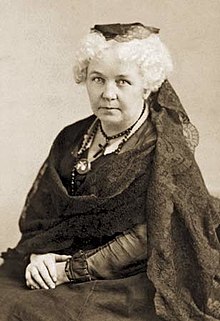Elizabeth Cady Stanton
| Elizabeth Cady Stanton | |
|---|---|

Elizabeth Cady Stanton, c. 1880
|
|
| Born |
Elizabeth Cady November 12, 1815 Johnstown, New York |
| Died | October 26, 1902 (aged 86) New York City, New York |
| Occupation | Writer, suffragist, women's rights activist, abolitionist |
| Spouse(s) | Henry Brewster Stanton (m. 1840) |
| Children |
|
| Parent(s) |
Daniel Cady (1773–1859) Margaret Livingston Cady (1785–1871) |
| Relatives |
Gerrit Smith, cousin Col. James Livingston, grandfather |
| Signature | |
Elizabeth Cady Stanton (November 12, 1815 – October 26, 1902) was an American suffragist, social activist, abolitionist, and leading figure of the early women's rights movement. Her Declaration of Sentiments, presented at the Seneca Falls Convention held in 1848 in Seneca Falls, New York, is often credited with initiating the first organized women's rights and women's suffrage movements in the United States. Stanton was president of the National Woman Suffrage Association from 1892 until 1900.
Before Stanton narrowed her political focus almost exclusively to women's rights, she was an active abolitionist with her husband Henry Brewster Stanton (co-founder of the Republican Party) and cousin Gerrit Smith. Unlike many of those involved in the women's rights movement, Stanton addressed various issues pertaining to women beyond voting rights. Her concerns included women's parental and custody rights, property rights, employment and income rights, divorce, the economic health of the family, and birth control. She was also an outspoken supporter of the 19th-century temperance movement.
After the American Civil War, Stanton's commitment to female suffrage caused a schism in the women's rights movement when she, together with Susan B. Anthony, declined to support passage of the Fourteenth and Fifteenth Amendments to the United States Constitution. She opposed giving added legal protection and voting rights to African American men while women, black and white, were denied those same rights. Her position on this issue, together with her thoughts on organized Christianity and women's issues beyond voting rights, led to the formation of two separate women's rights organizations that were finally rejoined, with Stanton as president of the joint organization, about twenty years after her break from the original women's suffrage movement. Stanton died in 1902, having written both The Woman's Bible and her autobiography Eighty Years and More, and many other articles and pamphlets about female suffrage and women's rights.
...
Wikipedia
